Joseph Smith Hypocephalus

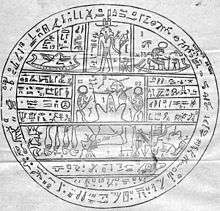
The Joseph Smith Hypocephalus (also known as the Hypocephalus of Sheshonq)[lower-alpha 1] was a papyrus fragment, part of the original Joseph Smith Papyri, found in the Gurneh area of Thebes, Egypt, around the year 1818.[1] The owner's name, Sheshonq, is found in the hieroglyphic text on said hypocephalus. Three hypocephali in the British Museum (37909, 8445c, and 8445f) are similar to the Joseph Smith Hypocephalus both in layout and text and were also found in Thebes.[1]
A woodcut image of the hypocephalus was initially published on March 15, 1842, in Volume III, No. 10 of the Latter Day Saint newspaper Times and Seasons, two years before the death of Joseph Smith, who was the editor of the Times and Seasons. This image is included as one of several appendices to the Book of Abraham, where it is called Facsimile No. 2. The Book of Abraham has been considered scripture by members of The Church of Jesus Christ of Latter-day Saints (LDS Church) since 1880. The location of the original document is unknown.
Hypocephali
Hypocephali are small disk-shaped objects, generally made of stuccoed linen, but also of papyrus, bronze, gold, wood, or clay, which were placed under the heads of the dead upon their burial. Hypocephali first appeared during the Egyptian Saite Dynasty (663–525 B.C.) and their use continued for centuries.
They were believed to protect the deceased, causing the head and body to be enveloped in light and warmth, thereby making the deceased divine. Hypocephali symbolized the Eye of Ra (Eye of Horus), which represented the sun, and the scenes portrayed on them relate to Egyptian ideas of resurrection and life after death, connecting them with the Osirian resurrection myth.
To the ancient Egyptians, the daily setting and rising of the sun was a symbol of death and rebirth. The hypocephalus represented all that the sun encircles — the world of the living, over which it passed during the day, was depicted in the upper half, and that of the dead, which it crossed during the night, in the lower portion.
As with other hypocephali, the Joseph Smith Hypocephalus contains the Eye of Shu, the Eye of Ra, or the Eye of Horus, and many other symbolic images which represent elements of ancient Egyptian religious belief. They were part of the burial materials created by Egyptians from the Twenty-sixth Dynasty onward.
Within the large circle are compartments containing hieroglyphic text and figures which are extracts from Chapter CLXII of the Egyptian Book of the Dead.[2] P. J. de Horrack stated that the scenes portrayed in hypocephali relate in all their details to the resurrection and the renewed birth after death...symbolized by the course of the Sun, the living image of divine generation. The circle is divided to represent two celestial hemispheres and the cycle of renewal.
Lacunae and reconstructions
As stated by LDS Egyptologist Michael D. Rhodes: "A careful examination of Facsimile No. 2 shows that there is a difference between most of the hieroglyphic signs and the signs on the right third of the figure on the outer edge as well as the outer portions of the sections numbered 12–15. These signs are hieratic, not hieroglyphic, and are inverted, or upside down, to the rest of the text. In fact, they are a fairly accurate copy of lines 2, 3, and 4 of the Joseph Smith Papyrus XI, which contains a portion of the Book of Breathings. Especially clear is the word snsn, in section 14, and part of the name of the mother of the owner of the papyrus, (tay-)uby.t, repeated twice on the outer edge. An ink drawing of the hypocephalus in the Church Historian's office shows these same areas as being blank. It is likely that these portions were destroyed on the original hypocephalus and someone (the engraver, one of Joseph Smith's associates, or Joseph himself) copied the lines from the Book of Breathings papyrus for aesthetic purposes."[1]
Interpretation of images (Figures No. 1-7, 22-23)
There is still some ambiguity regarding how these Egyptian names and text may have been pronounced.[3]
The numbers labeling the figures were added to correspond to explanations of the images and text given by Joseph Smith.
Figure No. 1
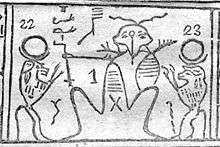
The central figure wears the undulating horns of the Ovis longpipes ram, which is symbolic of Khnum,[4] the first creator god. Khnum was the potter who molded the souls and bodies of all living things from the clay of the earth, and gave them the breath of life. He was described as the "ba" (spiritual force) of Re,[5][6][7] The head of the figure is atypically offset to the right. The crouching body is a typical hieroglyphic pose for the god.[8]
The characters above and to the left of the head are three ripples of water, a pennant and a single diagonal stroke:
|
Triple ripples (mw) indicate the global mass of water. Similar to the double ripples of (nn), the "Primeval Waters" or state of being before creation. Described in An's mythological cycle as "the waters," Nun lay inert, unending and indefinite, until Nun "rises" and "throws off" the waters to begin the act of creation. Nun is a "primordial soup" from which the Self-Created god drew the materials to create its children Shu and Tefnut (air and moisture, the Biblical "firmament"), who then created Geb (earth) and Nut (sky). An ideographic reading of these symbols would be; The spirit of god rippling the waters.[lower-alpha 2]
Left of center is the was scepter, or DJAM scepter,[9] which are symbols of serenity or strength.[10]
To the left, above the scepter, are characters that may be irrigated land, force or effort, and one cubit:[11]
|
Joseph Smith explained figure 1 as; "Kolob, signifying the first creation, nearest to the celestial, or the residence of God. First in government, the last pertaining to the measurement of time. The measurement according to celestial time, which celestial time signifies one day to a cubit. One day in Kolob is equal to a thousand years according to the measurement of this earth, which is called by the Egyptians Jah-oh-eh."[12]
Figures No. 22 and 23

On either side of the central, seated figure are baboons with upraised arms, wearing the lunar disk headdress, which represent the Egyptian god Thoth or Djehuty. In Egyptian pictiographic writings Thoth was often placed opposite Re, and represented a type of "night sun". Thoth was associated with truth and integrity, the regulation of time, record keeping and possession of secret knowledge. For example, Thoth provided Isis with the secret word formula she needed to resurrect Osiris.[13][14]
Adjacent to the baboons are two snakes which represent the primeval serpent, earth creator god Kematef, Sito or "Iru-to". In the Pyramid Texts 1146 Iru-to says; "I am the scribe of the Divine Book which says what has been and effects what is yet to be."
Joseph Smith explained figures 22 and 23 as: "the medium of Kli-flos-is-es, or Hah-ko-kau-beam, the stars represented by numbers (figures) 22 and 23, receiving light from the revolutions of Kolob."[12]
Figure No. 2

The standing figure has a double ram's head with undulating horns and wears the double crown, symbolic of Amun, god of creation. Plutarch quoted Manetho as saying that Amun meant "that which is concealed."
On Amun's shoulders are jackal heads. In his left hand is the staff of Wepwawet and to the right is an offering stand. Amun spoke his own name and brought forth the land of Egypt from the primordial sea (nun).[15][16]
This figure is very similar to one in the same position on the Hypocephalus of Tashenkhons[17] with the exception of lacking the ankh symbol, orientation of the figure and the associated text. In ancient Egypt it was believed that the gods had a secret name. Knowledge of this name gave others power over them.[18]
Michael D. Rhodes identified the hieroglyphs to the left as: "The name of this Mighty God."
| |||||||
| "The name of this Mighty God."[19] in hieroglyphs |
|---|
This reading identifies/represents the name of the god without actually writing it, similar to the use of YHWH in Hebrew texts.
Joseph Smith stated that this figure; "Stands next to Kolob, called by the Egyptians Oliblish, which is the next grand governing creation near to the celestial or the place where God resides; holding the key of power also, pertaining to other planets; as revealed from God to Abraham, as he offered sacrifice upon an altar, which he had built unto the Lord."[12]
Figure No. 3
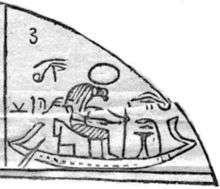
Also on the barque is an offering stand. The two characters farthest to the left may be an attempt to engrave dp.t ntr, which would translate as "Divine Ship":[19]
|
|
Alternatively, the entire row may be ideograms for a lotus flower (ssn) or grass (hn), a vaulted covering (ipt), a snake (similar to the one found at the foot of figure 23) (it 'father'?) and a sealed papyrus roll (md3t).[20]
|
|
In the religious tradition of ancient Heliopolis, Ra emerged from the petals of a lotus blossom which re-enfolded him each night.[21] The lotus was also a symbol of rebirth associated with Osiris. The Book of the Dead contains spells for "transforming oneself into a lotus", fulfilling the promise of resurrection.[22] According to the Pyramid Texts the snake Iru-to was the scribe of the Divine Book which said what has been and effects what is yet to be.
Joseph Smith's interpretation: "Is made to represent God, sitting upon his throne, clothed with power and authority; with a crown of eternal light upon his head; representing also the grand Key-words of the Holy Priesthood, as revealed to Adam in the Garden of Eden, as also to Seth, Noah, Melchizedek, Abraham, and all to whom the Priesthood was revealed."[12]
Figure No. 4

A falcon, representing Horus, 'lord of the sky',[23] or Sokar[1] sitting on a mummy case, with outstreatched wings, sitting upon a papyrus boat. This image is similar to the one in the same panel from the hypocephalus of Tashenkhons,[24] with the exception of the rudder and text. The Coffin Texts state; "He takes the ship of 1000 cubits from end to end and he sails it to the stairway of fire."
Joseph Smith's interpretation: "Answers to the Hebrew word Raukeeyang, signifying expanse, or the firmament of the heavens; also a numerical figure, in Egyptian signifying one thousand; answering to the measuring of the time of Oliblish, which is equal with Kolob in its revolution and in its measuring of time."[12]
Figure No. 5
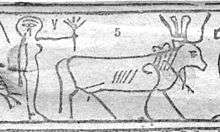
A cow, representing Hathor, who was the goddess of the sky, home of the great falcon. Behind is a standing female figure with the Eye of Horus depicted on her head and holding out a papyrus stem in her left hand. This image is similar to the one in the same panel from the hypocephalus of Tashenkhons.[24]
Joseph Smith's interpretation: "Is called in Egyptian Enish-go-on-dosh; this is one of the governing planets also, and is said by the Egyptians to be the Sun, and to borrow its light from Kolob through the medium of Kae-e-vanrash, which is the grand Key, or, in other words, the governing power, which governs fifteen other fixed planets or stars, as also Floeese or the Moon, the Earth and the Sun in their annual revolutions. This planet receives its power through the medium of Kli-flos-is-es, or Hah-ko-kau-beam, the stars represented by numbers 22 and 23, receiving light from the revolutions of Kolob."[12]
Figure No. 6
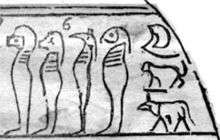
Four standing mummiform figures, representing the four sons of Horus (left to right); Imsety, Hapy, Duamutef and Qebesenuef, with the heads of a human, baboon, jackal, and falcon, who were associated with the south, north, east and west. They were the patron gods of the liver, lungs, stomach and intestines of the deceased and were protected by Isis, Nephthys, Neith and Serket.[25] The figures behind them are typically a lotus stem (h3), lion and ram.
Joseph Smith's interpretation: "Represents this earth in its four quarters."[12]
Figure No. 7
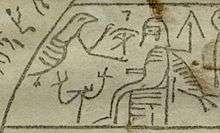
A seated figure with the tail of a falcon, symbolic of the supreme celestial deity,[26] with a human head and a pharonic beard. This figure has been identified with Min, a predynastic god who was usually depicted as a mummy wrapped ithyphallic man with his legs bound together, wearing a twin plumed crown with long streamers and with his arm raised to the square,[27] a gesture identified as the Sign of Preservation.[28] Behind his head is an inverted V. A right angle projects to the right of the shoulder. To the left is a figure with a bird's head, presenting the Eye of Ra. In the hypocephalus of Tashenkhons,[24] the figure on the left is Nehebu-Kau, whose name meant "he who harnesses the spirits" and the inverted V is a flail, symbolic of provenance.[29]
Joseph Smith's interpretation:"Represents God sitting upon his throne, revealing through the heavens the grand Key-words of the Priesthood; as, also, the sign of the Holy Ghost unto Abraham, in the form of a dove."[12]
Text to the left (Figures No. 8-11)
| Figure No. 11 |  |
"O god, sleeping in the time" |
|---|---|---|
| Figure No. 10 |  |
"of the beginning. Great God, Lord of Heaven and earth," |
| Figure No. 9 |  |
"and below the earth and of the waters" (Damaged in the original.) |
| Figure No. 8 |  |
"Grant that the Ba of Osiris Sheshonq live." |
Theodule Deveria gave the following translation: "O great God in Sekhem; O great God, Lord of heaven, earth and hell. ... Osiris S'es'enq."[30]
Michael D. Rhodes gives the following translation: "O God of the Sleeping Ones from the time of the creation. O Mighty God, Lord of heaven and earth, of the hereafter, and of his great waters, may the soul of the Osiris Shishaq be granted life."[1]
Robert K. Ritner gives the following translation: "O noble god from the beginning of time, great god, lord of heaven, earth, underworld, waters [and mountains,] cause the ba-spirit of the Osiris Sheshonq to live." (brackets and italics in original)[31]
Joseph Smith said of figure 8 in particular, "Contains writings that cannot be revealed unto the world; but is to be had in the Holy Temple of God."[12]
Text to the right (Figures No. 12-15)
| Figure No. 12 |  |
|---|---|
| Figure No. 13 |  |
| Figure No. 14 |  |
| Figure No. 15 |  |
The right portion of these characters are hieratic and appear to have been copied from Joseph Smith Papyrus XI.[19]
Included is sn-sn:[19]
|
|
Val Sederholm[32] has identified that the surviving traces of the original content parallel other hypocephali, and suggested the reading j nTr pfy 'A, 'nx m TAw, jw m mw: 'q r' jw [=r] sDm md.t=f. [Mj n] Wsjr, explaining that "the officiator, calling upon that special, particular, transcendent god, who lives by breathing, who negotiates the waters, pleads from the depths: May Re descend to hear Osiris' words! Come to Shoshenq, who is dead!"[33]
Text at the bottom (Figures No. 16-17)
 |
|---|
 |
| Figure No. 17: (h3t)tomb. (thy)desecration. (nn) strong negative. |
| Figure No. 16: "is not to be disturbed along with its Lord in the Duat forever." |
Michael D. Rhodes gives the following translation: "May this tomb never be desecrated, and may this soul and its lord never be desecrated in the hereafter."[1]
Robert K. Ritner gives the following translation: "Back, injury, back! There is none who attacks you. This ba-spirit and his lord will not be attacked in the underworld forever."[31]
Text around the rim (Figure No. 18)
One third of the rim contains characters taken from another papyrus. Michael D. Rhodes provided a possible reading of the text in its original state:
"I am the Provider in the Sun Temple in Heliopolis. [I am] most exalted and very glorious. [I am] a virile bull without equal. [I am] that Mighty God in the Sun Temple in Heliopolis. <May the Osiris Shishaq live forever> with that Mighty God in Heliopolis."[1]
Text to upper left (Figures No. 19-21, numbered 19,21-22 in Times and Seasons)
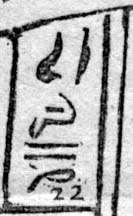 |
 |
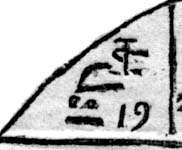 |
|---|---|---|
| "Behold thou art ever" | "as this god of thine" | "in(of) Busiris" |
Rhodes gives the following translation: "You shall ever be as that God, the Busirian."[1]
Notes
References
- 1 2 3 4 5 6 7 8 9 10 Rhodes, Michael D. "The Joseph Smith Hypocephalus . . . Twenty Years Later" (PDF). Retrieved 15 March 2014.
- ↑ The Mummy A Handbook of Egyptian Funerary Archaeology, E. A. Wallis Budge, Second Edition Reprint, pgs. 476-477
- ↑ http://www.friesian.com/egypt.htm, The Pronunciation of Ancient Egyptian
- ↑ The Complete Gods and Goddesses of Egypt, Richard H. Wilkinson, 2003, pg. 95
- ↑ The Complete Gods and Goddesses of Egypt, Richard H. Wilkinson, 2003, pg. 32.
- ↑ Amun-Re/Chnum - Fig 1 on Hypocephalus examined in light of Egyptological/Archaeological Information
- ↑ The Complete Gods and Goddesses of Egypt, Richard H. Wilkinson, 2003, pg. 194.
- ↑ The Complete Gods and Goddesses of Egypt, Richard H. Wilkinson, 2003, pg. 29.
- ↑ The Three Facsimiles from the Book of Abraham (1980), Hugh Nibley
- ↑ An Egyptian Hieroglyphic Dictionary, E.A. Wallis Budge, pg. cxxxvi
- ↑ Egyptian Grammar, Gardiner, 3rd Ed, 1982, pgs. 544-545
- 1 2 3 4 5 6 7 8 9 Smith, Joseph; The Book of Abraham: Facsimile No. 2: Explanation - available on Wikisource and on LDS.org
- ↑ The Complete Gods and Goddesses of Egypt, Richard H. Wilkinson, 2003, pgs. 215-217.
- ↑ Egyptian Ideas of the Future Life, Budge, pg. 195
- ↑ The Complete Gods and Goddesses of Egypt, pgs. 92-93
- ↑ Budge, Egyptian Ideas of the Future Life, pg. 41 & 45
- ↑ http://www.ancient-egypt.co.uk/ashmolean/pages/2005-mar-11%20472.htm
- ↑ Understanding Hieroglyphs, Hilary Wilson, 1993, pg. 15
- 1 2 3 4 The Joseph Smith Hypocephalus - Seventeen Years Later
- ↑ Hieroglyphics: The Writings of Ancient Egypt, Maria Carmela Betrò, 1995
- ↑ Symbols From The Middle East
- ↑ Ancient Egypt: the Mythology - Lotus
- ↑ The Complete Gods and Goddesses of Ancient Egypt, pg. 200
- 1 2 3 Two Hypocephali
- ↑ The Complete Gods and Goddesses of Egypt, Richard H. Wilkinson, 2003, pg. 88
- ↑ The Thames and Hudson Dictionary of Egypt, Toby Wilkinson , 2005, pg. 79
- ↑ The Complete Gods and Goddesses of Egypt, pg. 115-116
- ↑ Secret Sign Languages by J.S.M. Ward, M.A.,Land's End Press, 1969, pgs. 13-14
- ↑ The Complete Gods and Goddesses of Egypt, pgs. 224-225
- 1 2 Quoted here: https://books.google.com/books?id=UEgOAAAAIAAJ&pg=PA515
- 1 2 Quoted and attributed here: http://user.xmission.com/~research/mormonpdf/hypocephalus3.pdf
- ↑ PhD, Egyptology
- 1 2 Sederholm, Val. "Restoring the Right Panels on LDS Book of Abraham Facsimile 2 (New Translations)". Retrieved 21 September 2016.
External links
 Media related to Book of Abraham Facsimile Number 2 at Wikimedia Commons
Media related to Book of Abraham Facsimile Number 2 at Wikimedia Commons